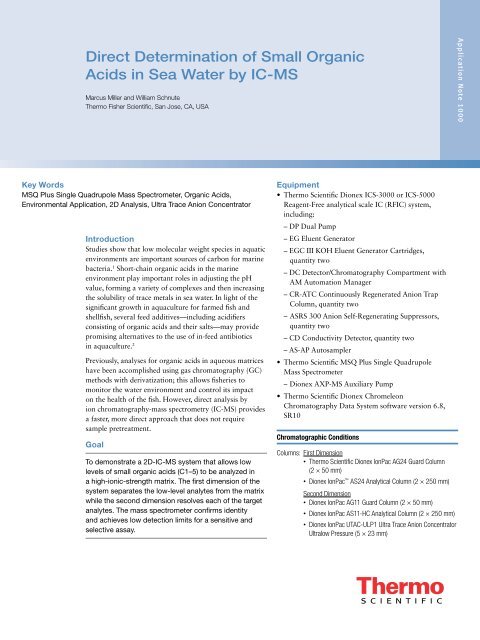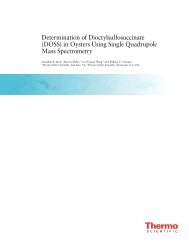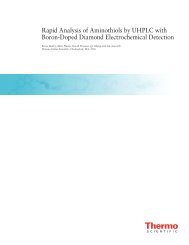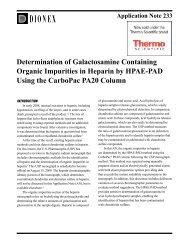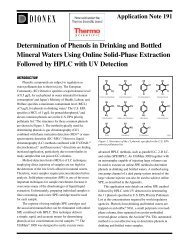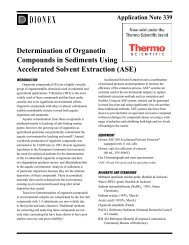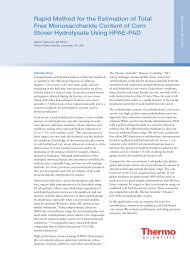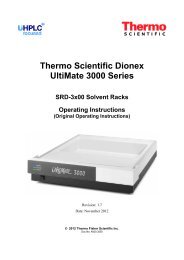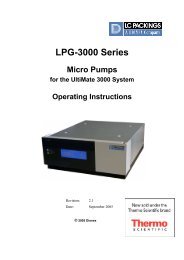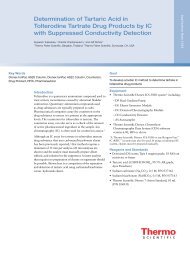Direct Determination of Small Organic Acids in Sea Water ... - Dionex
Direct Determination of Small Organic Acids in Sea Water ... - Dionex
Direct Determination of Small Organic Acids in Sea Water ... - Dionex
Create successful ePaper yourself
Turn your PDF publications into a flip-book with our unique Google optimized e-Paper software.
<strong>Direct</strong> <strong>Determ<strong>in</strong>ation</strong> <strong>of</strong> <strong>Small</strong> <strong>Organic</strong><br />
<strong>Acids</strong> <strong>in</strong> <strong>Sea</strong> <strong>Water</strong> by IC-MS<br />
Marcus Miller and William Schnute<br />
Thermo Fisher Scientific, San Jose, CA, USA<br />
Key Words<br />
MSQ Plus S<strong>in</strong>gle Quadrupole Mass Spectrometer, <strong>Organic</strong> <strong>Acids</strong>,<br />
Environmental Application, 2D Analysis, Ultra Trace Anion Concentrator<br />
Introduction<br />
Studies show that low molecular weight species <strong>in</strong> aquatic<br />
environments are important sources <strong>of</strong> carbon for mar<strong>in</strong>e<br />
bacteria. 1 Short-cha<strong>in</strong> organic acids <strong>in</strong> the mar<strong>in</strong>e<br />
environment play important roles <strong>in</strong> adjust<strong>in</strong>g the pH<br />
value, form<strong>in</strong>g a variety <strong>of</strong> complexes and then <strong>in</strong>creas<strong>in</strong>g<br />
the solubility <strong>of</strong> trace metals <strong>in</strong> sea water. In light <strong>of</strong> the<br />
significant growth <strong>in</strong> aquaculture for farmed fish and<br />
shellfish, several feed additives—<strong>in</strong>clud<strong>in</strong>g acidifiers<br />
consist<strong>in</strong>g <strong>of</strong> organic acids and their salts—may provide<br />
promis<strong>in</strong>g alternatives to the use <strong>of</strong> <strong>in</strong>-feed antibiotics<br />
<strong>in</strong> aquaculture. 2<br />
Previously, analyses for organic acids <strong>in</strong> aqueous matrices<br />
have been accomplished us<strong>in</strong>g gas chromatography (GC)<br />
methods with derivatization; this allows fisheries to<br />
monitor the water environment and control its impact<br />
on the health <strong>of</strong> the fish. However, direct analysis by<br />
ion chromatography-mass spectrometry (IC-MS) provides<br />
a faster, more direct approach that does not require<br />
sample pretreatment.<br />
Goal<br />
To demonstrate a 2D-IC-MS system that allows low<br />
levels <strong>of</strong> small organic acids (C1–5) to be analyzed <strong>in</strong><br />
a high-ionic-strength matrix. The first dimension <strong>of</strong> the<br />
system separates the low-level analytes from the matrix<br />
while the second dimension resolves each <strong>of</strong> the target<br />
analytes. The mass spectrometer confirms identity<br />
and achieves low detection limits for a sensitive and<br />
selective assay.<br />
Equipment<br />
• Thermo Scientific <strong>Dionex</strong> ICS-3000 or ICS-5000<br />
Reagent-Free analytical scale IC (RFIC) system,<br />
<strong>in</strong>clud<strong>in</strong>g:<br />
– DP Dual Pump<br />
– EG Eluent Generator<br />
– EGC III KOH Eluent Generator Cartridges,<br />
quantity two<br />
– DC Detector/Chromatography Compartment with<br />
AM Automation Manager<br />
– CR-ATC Cont<strong>in</strong>uously Regenerated Anion Trap<br />
Column, quantity two<br />
– ASRS 300 Anion Self-Regenerat<strong>in</strong>g Suppressors,<br />
quantity two<br />
– CD Conductivity Detector, quantity two<br />
– AS-AP Autosampler<br />
• Thermo Scientific MSQ Plus S<strong>in</strong>gle Quadrupole<br />
Mass Spectrometer<br />
– <strong>Dionex</strong> AXP-MS Auxiliary Pump<br />
• Thermo Scientific <strong>Dionex</strong> Chromeleon<br />
Chromatography Data System s<strong>of</strong>tware version 6.8,<br />
SR10<br />
Chromatographic Conditions<br />
Columns: First Dimension<br />
• Thermo Scientific <strong>Dionex</strong> IonPac AG24 Guard Column<br />
(2 × 50 mm)<br />
• <strong>Dionex</strong> IonPac AS24 Analytical Column (2 × 250 mm)<br />
Second Dimension<br />
• <strong>Dionex</strong> IonPac AG11 Guard Column (2 × 50 mm)<br />
• <strong>Dionex</strong> IonPac AS11-HC Analytical Column (2 × 250 mm)<br />
• <strong>Dionex</strong> IonPac UTAC-ULP1 Ultra Trace Anion Concentrator<br />
Ultralow Pressure (5 × 23 mm)<br />
Application Note 1000
2<br />
Mobile Phase: Two Electrolytically Generated KOH Gradients<br />
Gradient 1: Time (m<strong>in</strong>) Conc (mM)<br />
-5.0 10<br />
0.1 10<br />
10.0 15<br />
10.1 60<br />
20.9 60<br />
21.0 10<br />
33.1 10<br />
Gradient 2: Time (m<strong>in</strong>) Conc (mM)<br />
-5.0 1<br />
13.0 1<br />
23.0 4<br />
28.0 60<br />
33.0 60<br />
33.1 1<br />
Flow Rate: 0.4 mL/m<strong>in</strong> for both 1st and 2nd dimensions<br />
Inj. Volume: 25 µL<br />
Temperature: 35 °C<br />
Detection: Suppressed conductivity: <strong>Dionex</strong> ASRS 300<br />
Anion Self-Regenerat<strong>in</strong>g Suppressor , 2 mm,<br />
external water mode (2 mL/m<strong>in</strong>)<br />
Suppressor 1: Time (m<strong>in</strong>) Current mA<br />
-5.0 15<br />
10.0 15<br />
10.1 60<br />
28.0 15<br />
Suppressor 2: Time (m<strong>in</strong>) Current mA<br />
-5.0 2<br />
23.0 10<br />
28.0 60<br />
36.0 4<br />
MS Parameters<br />
ESI: Negative ion<br />
SIM Scans: 0.7 m/z span, dwell time 0.2 s/scan<br />
N Pressure: 2 80 psi<br />
Probe Temperature: 500 °C<br />
Needle Voltage: 4 kV<br />
Scan Parameters: Name Mass (m/z) Cone Voltage (V)<br />
Acetate 44.9 50<br />
Formate 58.9 45<br />
Propionate 73.0 45<br />
Butyrate/pyruvate 86.85 45<br />
Valerate 100.85 45<br />
Plumb the two divert valves <strong>in</strong> the Automation Manager<br />
after the CD detectors. One valve enables the 2D system<br />
to operate; the other valve directs unwanted compounds<br />
away from the mass spectrometer. Add a flow <strong>of</strong> 0.4 mL/<br />
m<strong>in</strong> <strong>of</strong> acetonitrile via a low-volume mix<strong>in</strong>g tee prior to<br />
the mass spectrometer (see Figure 1) to aid with the<br />
thermally assisted pneumatic nebulization <strong>of</strong> the<br />
electrospray ionization (ESI) source.<br />
2D-IC Valve (Eluent Flow)<br />
Time (m<strong>in</strong>) Position<br />
-5 Trap column connected to <strong>Dionex</strong> IonPac<br />
AS11-HC column<br />
0 Trap column connected to <strong>Dionex</strong> IonPac<br />
AS24 column<br />
8 Trap column connected to <strong>Dionex</strong> IonPac<br />
AS11-HC column<br />
MS Divert Valve (Eluent Flow)<br />
Time (m<strong>in</strong>) Position<br />
-5 To waste<br />
8 To mass spectrometer<br />
28 To waste<br />
Chemicals and Reagents<br />
• Sodium acetate (Fluka P/N 71179)<br />
• Sodium formate (Sigma-Aldrich ® P/N 71541)<br />
• Propionic acid (Sigma-Aldrich P/N P1386)<br />
• Sodium butyrate (Sigma-Aldrich P/N B5887)<br />
• Valeric acid (Sigma-Aldrich P/N 240370)<br />
• Pyruvic acid sodium salt (Kodak P/N 8719)<br />
• Sodium propionate-d5 (CDN Isotopes P/N D-5378)<br />
• Acetonitrile, HPLC grade (Honeywell Burdick &<br />
Jackson P/N AH015-4)<br />
• Deionized (DI) water, 18.2 MΩ-cm resistivity<br />
• Synthetic sea water (SW): prepare from a commercially<br />
available synthetic sea salt (Instant Ocean ® <strong>Sea</strong> Salt) by<br />
dissolv<strong>in</strong>g 30 g <strong>of</strong> salt <strong>in</strong>to 1 L <strong>of</strong> DI water<br />
Prepare a primary stock solution <strong>of</strong> each <strong>of</strong> the six<br />
organic acids at 1000 µg/mL (ppm) <strong>in</strong> DI water. Prepare a<br />
mixture <strong>of</strong> the six acids at 100 ppm <strong>in</strong> DI water. Prepare<br />
work<strong>in</strong>g stock solutions by dilut<strong>in</strong>g the primary stock<br />
mixture to 10 ppm and 100 ppb concentrations <strong>in</strong> both<br />
DI and SW. Prepare calibration standards by us<strong>in</strong>g the DI<br />
water mixture stocks. Prepare SW samples by dilution <strong>of</strong><br />
the SW stock.
Table 1. Summary <strong>of</strong> results for organic acids analysis<br />
% Recovery <strong>in</strong> DI <strong>Water</strong><br />
Compound Corr. Coeff. MDL (ppb) 100 ppb 1 ppm<br />
Acetate 99.993 100 — 88<br />
Formate 99.995 200 — 103<br />
Propionate 99.991 15.5 102 99<br />
Butyrate 99.998 7.8 90 96<br />
Pyruvate 99.991 5.6 105 107<br />
Valerate 99.987 3.8 93 108<br />
Calibration<br />
Prepare the mixture <strong>of</strong> six organic acids <strong>in</strong> synthetic<br />
SW at 10 concentrations: 5, 10, 20, 50, 100, 200, and<br />
500 ppb; and 1, 2, and 5 ppm. Spike an <strong>in</strong>ternal standard<br />
<strong>of</strong> propionate-d 5 at 100 ppb <strong>in</strong>to each <strong>of</strong> the standards.<br />
Full-loop <strong>in</strong>jections <strong>of</strong> 25 µL will yield a total amount <strong>of</strong><br />
125 pg to 125 ng loaded on column. Prepare samples <strong>in</strong><br />
DI water spiked at 100 ppb and 1 ppm to evaluate the<br />
recovery efficiency <strong>of</strong> the system (Table 1).<br />
Chromatography<br />
The SW matrix necessitates use <strong>of</strong> a 2D-IC analysis. In the<br />
first dimension, the <strong>Dionex</strong> IonPac AS24 column weakly<br />
reta<strong>in</strong>s the organic acids but reta<strong>in</strong>s the <strong>in</strong>organic<br />
components more strongly. Thus, the early elut<strong>in</strong>g organic<br />
Waste<br />
Divert Valve 1<br />
Concentrator<br />
<strong>Dionex</strong> IonPac<br />
UTAC-ULP1<br />
Pump-2<br />
EGC-2 (KOH)<br />
CD-1<br />
Suppressor-1<br />
<strong>Dionex</strong> ASRS 300<br />
Anion Self-Regenerat<strong>in</strong>g<br />
Suppressor (2 mm)<br />
Figure 1. Schematics for 2D-IC-MS system<br />
Analytical Column<br />
<strong>Dionex</strong> IonPac<br />
AG & AS11-HC<br />
Waste<br />
<strong>Dionex</strong> IonPac AG & AS24<br />
Matrix Elim<strong>in</strong>ation Column<br />
acids can be trapped onto a <strong>Dionex</strong> IonPac UTAC-ULP1<br />
trap column. A primary divert valve (Divert Valve 1 <strong>in</strong><br />
Figure 1) controls flow to the <strong>Dionex</strong> IonPac UTAC-<br />
ULP1 trap column, allow<strong>in</strong>g trapp<strong>in</strong>g from the <strong>Dionex</strong><br />
IonPac AS24 column <strong>in</strong>itially, and then connect<strong>in</strong>g the<br />
trap cartridge to the <strong>Dionex</strong> IonPac AS11-HC column<br />
flow path at a later time to allow for separation and<br />
analysis <strong>of</strong> just the organic acids. A secondary divert<br />
valve (Divert Valve 2 <strong>in</strong> Figure 1) allows analytes elut<strong>in</strong>g<br />
from the <strong>Dionex</strong> IonPac AS11-HC column to be directed<br />
to the mass spectrometer for detection but directs flow to<br />
waste at all other times to reduce the chance <strong>of</strong> background<br />
or matrix affect<strong>in</strong>g the ESI spray <strong>in</strong>terface.<br />
<strong>Dionex</strong> ASRS 300<br />
Anion Self-Regenerat<strong>in</strong>g<br />
Suppressor (2 mm)<br />
Suppressor-2<br />
AS-AP Autosampler<br />
CD-2<br />
Waste<br />
External <strong>Water</strong><br />
Injection Valve<br />
Injection Loop<br />
Divert Valve 2<br />
EGC-1 (KOH)<br />
Static Mix<strong>in</strong>g Tee<br />
MSQ Plus<br />
Mass Spectometer<br />
Pump-1<br />
0.2 mL/m<strong>in</strong><br />
CH 3 CN<br />
<strong>Dionex</strong><br />
AXP-MS<br />
Auxiliary<br />
Pump<br />
3
4 Set the two IC channels so that while one column is used for<br />
separation <strong>of</strong> the analytes, the other column is be<strong>in</strong>g cleaned<br />
and equilibrated for the next sample. After the analytes elute<br />
<strong>of</strong>f the <strong>Dionex</strong> IonPac AS24 column and the primary divert<br />
valve changes position so that the <strong>Dionex</strong> IonPac AS24<br />
column is then connected directly to waste, rapidly <strong>in</strong>crease<br />
the eluent strength and hold it at high concentration to<br />
quickly wash <strong>of</strong>f <strong>in</strong>organic components. Simultaneously<br />
raise the suppressor current to compensate for <strong>in</strong>creased<br />
eluent concentration and ma<strong>in</strong>ta<strong>in</strong> suppressed conditions.<br />
Then return the eluent strength to start<strong>in</strong>g conditions and<br />
allow the column to equilibrate while complet<strong>in</strong>g the<br />
analysis on the <strong>Dionex</strong> IonPac AS11-HC column.<br />
Return suppressor current to its lower level for better<br />
basel<strong>in</strong>e stability while eluent concentration is low dur<strong>in</strong>g<br />
analyte elution. Likewise, while the <strong>Dionex</strong> IonPac<br />
AS11-HC column is equilibrat<strong>in</strong>g for the next sample,<br />
the <strong>Dionex</strong> IonPac AS24 column will be load<strong>in</strong>g the trap<br />
cartridge (Figure 2). By overlapp<strong>in</strong>g functionality <strong>in</strong> this<br />
way, the total run time for multiple samples is reduced.<br />
Mass Spectrometry<br />
The aim <strong>of</strong> the study was to develop a selective and<br />
sensitive method for direct analysis <strong>of</strong> trace levels <strong>of</strong><br />
small organic acids <strong>in</strong> sea water samples. The mass<br />
spectrometer provides <strong>in</strong>herent selectivity based on m/z,<br />
and operation <strong>in</strong> selected ion monitor<strong>in</strong>g (SIM) mode<br />
provides <strong>in</strong>creased sensitivity and specificity. All <strong>of</strong> the<br />
acids ionized easily <strong>in</strong> the ESI source and ionization<br />
parameter optimization was straightforward. Each<br />
<strong>in</strong>dividual analyte was evaluated with respect to cone<br />
voltage, whereas a s<strong>in</strong>gle needle voltage and probe<br />
temperature were chosen to give the best compromise <strong>in</strong><br />
overall results. Optimal parameters are recorded <strong>in</strong> the<br />
Chromatographic Conditions section.<br />
The SIM dwell times were chosen to provide sufficient<br />
acquisition rates to yield good peak shape given the<br />
chromatographic width <strong>of</strong> the peaks. Dwell time is<br />
a compromise: longer times result <strong>in</strong> greater signal<br />
accumulation and better signal-to-noise ratio (S/N), but<br />
reduce the number <strong>of</strong> po<strong>in</strong>ts across the chromatographic<br />
peak. Narrow chromatographic peaks require shorter<br />
dwell times for sampl<strong>in</strong>g to sample enough data po<strong>in</strong>ts to<br />
accurately characterize the peak. Optimal parameters for<br />
MS analysis are <strong>in</strong>strument- and compound-dependent;<br />
therefore, chemists wish<strong>in</strong>g to repeat these experiments<br />
are advised to evaluate all acquisition parameters to<br />
determ<strong>in</strong>e optimal values for different systems and<br />
analytes.<br />
Results and Discussion<br />
The result <strong>of</strong> the optimized analysis was sufficient<br />
separation <strong>of</strong> the analytes from the background matrix,<br />
thus allow<strong>in</strong>g low-level sensitivity by mass spectrometric<br />
detection while ma<strong>in</strong>ta<strong>in</strong><strong>in</strong>g a rugged overall analysis<br />
(Figure 3). Calibration curves and limits <strong>of</strong> detection are<br />
enumerated <strong>in</strong> Table 1.<br />
2,000<br />
µS<br />
Trap first 7 m<strong>in</strong> onto<br />
<strong>Dionex</strong> IonPac UTAC-ULP1<br />
1<br />
2<br />
60.00<br />
Peaks:<br />
1. Chloride<br />
2. Sulfate<br />
0<br />
15.00<br />
10.00<br />
-200<br />
EGC_1.Concentration: 10.00 mM<br />
0 2.5 5 7.5 10 12.5 15 17.5 20 22.5 25 27.5 30 32.5<br />
M<strong>in</strong>utes<br />
36<br />
Figure 2. First dimension (<strong>Dionex</strong> IonPac AS24 column)<br />
90<br />
µS<br />
3.78<br />
µS<br />
Peaks:<br />
1. Acetate 4. Butyrate<br />
2. Propionate 5. Pyruvate<br />
3. Formate 6. Valerate<br />
1<br />
2<br />
3<br />
4 5<br />
-0.47<br />
15.31 16 17 18 19 20 21 22 23 24 24.74<br />
M<strong>in</strong>utes<br />
0<br />
EGC_2.Concentration:<br />
1.00 mM<br />
4.00<br />
1.00<br />
-10<br />
0 2.5 5 7.5 10 12.5 15 17.5 20 22.5 25 27.5 30 32.5 36<br />
M<strong>in</strong>utes<br />
Figure 3. Second dimension (<strong>Dionex</strong> IonPac AS11-HC column)<br />
6<br />
60.00
Method Performance<br />
Selectivity for the six organic acids was established<br />
through use <strong>of</strong> SIM scans on the pseudo-molecular ion<br />
(M-H)- (Figure 4). When comb<strong>in</strong>ed with chromatographic<br />
retention times, this ensured accurate identification <strong>of</strong><br />
the analytes. Run-to-run precision and accuracy was<br />
evaluated by n<strong>in</strong>e replicate <strong>in</strong>jections <strong>of</strong> a low-level<br />
standard at 20 ppb. Method detection limits (MDLs)<br />
for propionate, butyrate, pyruvate, and valerate were<br />
estimated us<strong>in</strong>g the standard deviation obta<strong>in</strong>ed and the<br />
follow<strong>in</strong>g equation:<br />
MDL = S × t , n - 1 = 8<br />
99%<br />
where S is the standard deviation and t is the Student’s t<br />
at 99% confidence <strong>in</strong>terval.<br />
MDLs for acetate and formate were based on the<br />
m<strong>in</strong>imum level needed to achieve a S/N ≥3. Carryover was<br />
evaluated by <strong>in</strong>ject<strong>in</strong>g sample blanks (DI water) after a<br />
5 ppm standard chromatographic run. All analytes <strong>in</strong> the<br />
carryover analysis were below the MDLs.<br />
This method illustrates that good separation can be<br />
achieved with use <strong>of</strong> the <strong>Dionex</strong> IonPac AS24 and<br />
AS11-HC columns. When comb<strong>in</strong>ed with the selectivity<br />
and sensitivity <strong>of</strong> the MSQ Plus Mass Spectrometer,<br />
this approach provides accurate identification and<br />
quantification <strong>of</strong> each compound.<br />
90,000<br />
0<br />
Peaks:<br />
1. Acetate<br />
2. Propionate<br />
3. Formate<br />
4. Butyrate<br />
5. Pyruvate<br />
6. Valerate<br />
-10,000<br />
6 12<br />
Figure 4. SIM traces from MS<br />
www.thermoscientific.com<br />
©2012 Thermo Fisher Scientific Inc. All rights reserved. ISO is a trademark <strong>of</strong> the International Standards Organization.<br />
Instant Ocean is a registered trademark <strong>of</strong> Spectrum Brands. Sigma-Aldrich is a registered trademark <strong>of</strong> Sigma-Aldrich Co.<br />
LLC. Fluka is a trademark <strong>of</strong> Fluka Analytical. Kodak is a trademark <strong>of</strong> Eastman Kodak Co. Corp. CDN Isotopes is a registered<br />
trademark <strong>of</strong> C/D/N Isotopes Inc. Honeywell Burdick & Jackson is a trademark <strong>of</strong> Honeywell International Inc. All other<br />
trademarks are the property <strong>of</strong> Thermo Fisher Scientific Inc. and its subsidiaries. Specifications, terms and pric<strong>in</strong>g are<br />
subject to change. Not all products are available <strong>in</strong> all countries. Please consult your local sales representative for details.<br />
This <strong>in</strong>formation is presented as an example <strong>of</strong> the capabilities <strong>of</strong> Thermo Fisher products. It is not <strong>in</strong>tended to encourage use<br />
<strong>of</strong> these products <strong>in</strong> any manners that might <strong>in</strong>fr<strong>in</strong>ge the <strong>in</strong>tellectual property rights <strong>of</strong> others.<br />
U.S./Canada (847) 295 7500<br />
Australia (61) 2 9420 5233<br />
Austria (43) 1 616 51 25<br />
Benelux (31) 20 683 9768<br />
(32) 3 353 42 94<br />
18<br />
M<strong>in</strong>utes<br />
Brazil (55) 11 3731 5140<br />
Ch<strong>in</strong>a (852) 2428 3282<br />
Denmark (45) 36 36 90 90<br />
France (33) 1 39 30 01 10<br />
Germany (49) 6126 991 0<br />
India (91) 22 2764 2735<br />
Ireland (353) 1 644 0064<br />
Italy (39) 02 51 62 1267<br />
Japan (81) 6 6885 1213<br />
Korea (82) 2 3420 8600<br />
Conclusion<br />
This analysis for small organic acids, us<strong>in</strong>g a 2D-IC<br />
system, allows low levels <strong>of</strong> target analytes to be detected<br />
<strong>in</strong> a high-background matrix. The MSQ Plus Mass<br />
Spectrometer provides additional selectivity and sensitivity<br />
through use <strong>of</strong> the SIM function to achieve low detection<br />
limits. No special sample preparation was required and<br />
the results show good precision and reproducibility.<br />
References<br />
1. Rob<strong>in</strong>son, G. G.; Hendzel, L. L.; Gillespie, D. C. A<br />
Relationship Between Heterotrophic Utilization <strong>of</strong><br />
<strong>Organic</strong> <strong>Acids</strong> and Bacterial Populations <strong>in</strong> West Blue<br />
Lake, Manitoba. Limnol. Oceanogr. 1973, 18,<br />
264–269.<br />
2. Lückstädt, C. The Use <strong>of</strong> Acidifiers <strong>in</strong> Fisheries and<br />
Aquaculture. Partially based on the book chapter<br />
entitled: Effect <strong>of</strong> organic acid conta<strong>in</strong><strong>in</strong>g additives <strong>in</strong><br />
worldwide aquaculture – susta<strong>in</strong>able production the<br />
non-antibiotic way. In Acidifiers <strong>in</strong> Animal Nutrition;<br />
Lückstädt, C., Ed.; Nott<strong>in</strong>gham University Press:<br />
Nott<strong>in</strong>gham, United K<strong>in</strong>gdom, 2007. [Onl<strong>in</strong>e] www.<br />
wfish.de/fulltext/efeedl<strong>in</strong>k-com_use_<strong>of</strong>_acidifiers_<strong>in</strong>_<br />
fisheries_and_aquaculture.pdf (accessed April 11, 2012).<br />
24<br />
400,000<br />
1<br />
2<br />
counts counts<br />
3<br />
4<br />
5<br />
6<br />
0<br />
-50,000<br />
30<br />
Thermo Scientific <strong>Dionex</strong> products are,<br />
designed, developed, and manufactured<br />
under an ISO 9001 Quality System.<br />
S<strong>in</strong>gapore (65) 6289 1190<br />
Sweden (46) 8 473 3380<br />
Switzerland (41) 62 205 9966<br />
Taiwan (886) 2 8751 6655<br />
United K<strong>in</strong>gdom (44) 1276 691722<br />
AN70185 _E 07/12S<br />
Application Note 1000


